Necrotizing Fasciitis: Etiology, Diagnosis, and Management Strategies
VerifiedAdded on 2023/01/17
|9
|1959
|35
Essay
AI Summary
This essay provides a detailed overview of necrotizing fasciitis, a severe bacterial infection often referred to as the flesh-eating disease. It begins with an introduction to the condition, highlighting its rapid spread and potential for fatality. The essay then delves into the etiology of the disease, focusing on Staphylococcus aureus as a primary cause, along with other bacteria like Clostridium and E. coli. The causes are linked to entry points like wounds, cuts, and surgical sites. The essay thoroughly describes the signs and symptoms, which can initially mimic other conditions, and the diagnostic procedures, including biopsies and imaging tests. Treatment methods, such as medication, surgery, and antibiotic therapy, are discussed, along with preventive measures like wound care and hygiene. The essay concludes by summarizing the key aspects of necrotizing fasciitis, emphasizing the importance of early detection and intervention.
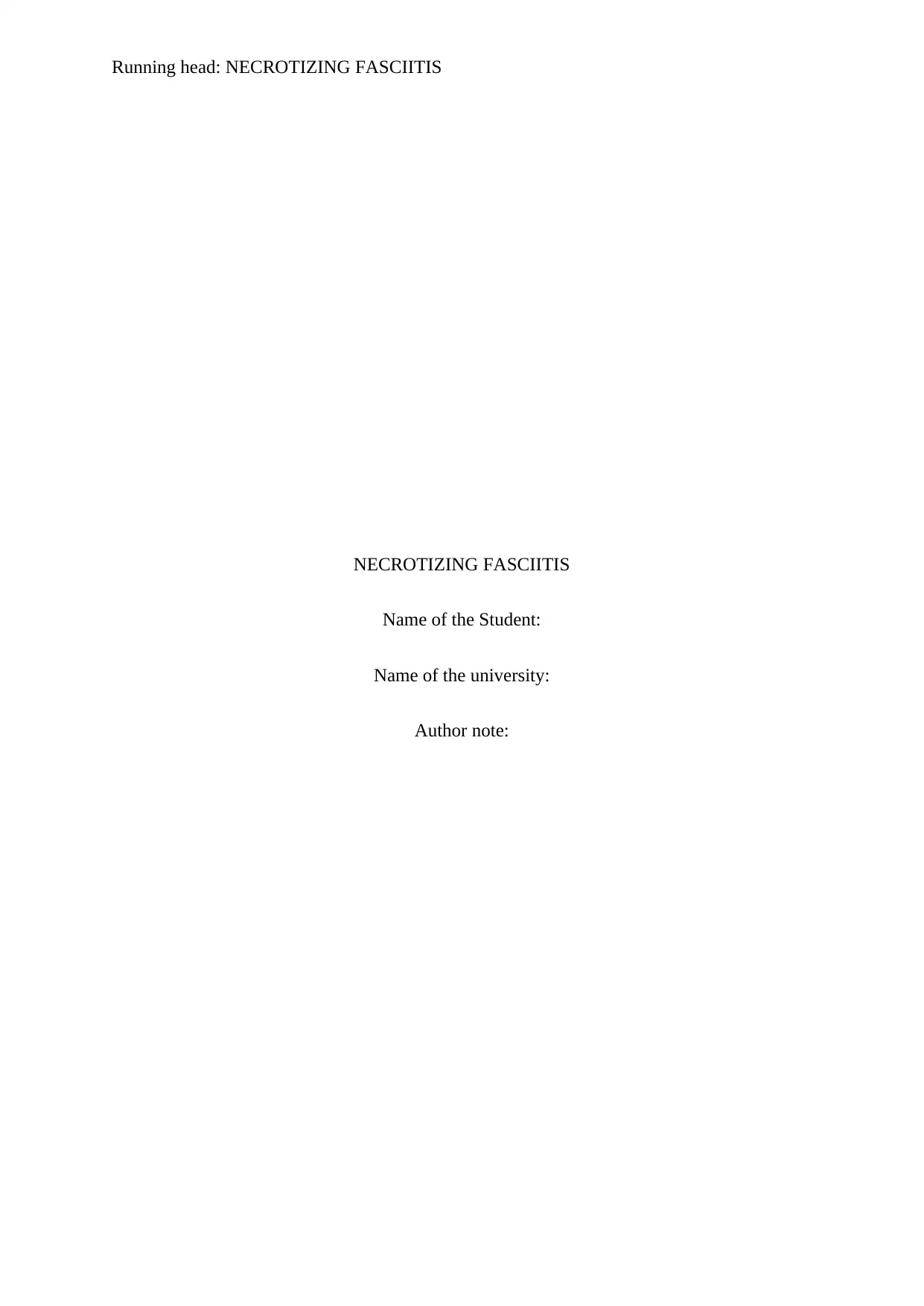
Running head: NECROTIZING FASCIITIS
NECROTIZING FASCIITIS
Name of the Student:
Name of the university:
Author note:
NECROTIZING FASCIITIS
Name of the Student:
Name of the university:
Author note:
Paraphrase This Document
Need a fresh take? Get an instant paraphrase of this document with our AI Paraphraser
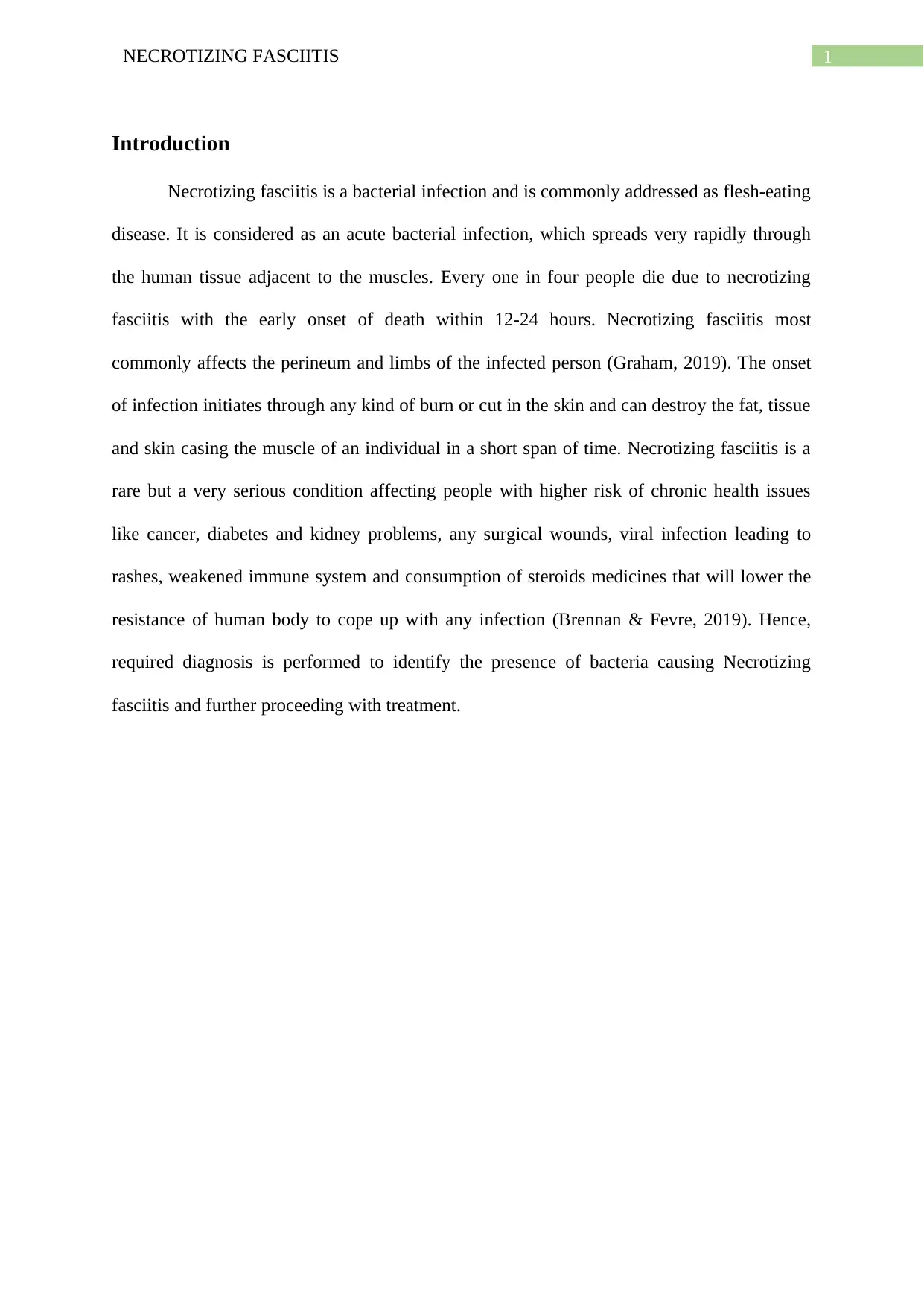
1NECROTIZING FASCIITIS
Introduction
Necrotizing fasciitis is a bacterial infection and is commonly addressed as flesh-eating
disease. It is considered as an acute bacterial infection, which spreads very rapidly through
the human tissue adjacent to the muscles. Every one in four people die due to necrotizing
fasciitis with the early onset of death within 12-24 hours. Necrotizing fasciitis most
commonly affects the perineum and limbs of the infected person (Graham, 2019). The onset
of infection initiates through any kind of burn or cut in the skin and can destroy the fat, tissue
and skin casing the muscle of an individual in a short span of time. Necrotizing fasciitis is a
rare but a very serious condition affecting people with higher risk of chronic health issues
like cancer, diabetes and kidney problems, any surgical wounds, viral infection leading to
rashes, weakened immune system and consumption of steroids medicines that will lower the
resistance of human body to cope up with any infection (Brennan & Fevre, 2019). Hence,
required diagnosis is performed to identify the presence of bacteria causing Necrotizing
fasciitis and further proceeding with treatment.
Introduction
Necrotizing fasciitis is a bacterial infection and is commonly addressed as flesh-eating
disease. It is considered as an acute bacterial infection, which spreads very rapidly through
the human tissue adjacent to the muscles. Every one in four people die due to necrotizing
fasciitis with the early onset of death within 12-24 hours. Necrotizing fasciitis most
commonly affects the perineum and limbs of the infected person (Graham, 2019). The onset
of infection initiates through any kind of burn or cut in the skin and can destroy the fat, tissue
and skin casing the muscle of an individual in a short span of time. Necrotizing fasciitis is a
rare but a very serious condition affecting people with higher risk of chronic health issues
like cancer, diabetes and kidney problems, any surgical wounds, viral infection leading to
rashes, weakened immune system and consumption of steroids medicines that will lower the
resistance of human body to cope up with any infection (Brennan & Fevre, 2019). Hence,
required diagnosis is performed to identify the presence of bacteria causing Necrotizing
fasciitis and further proceeding with treatment.
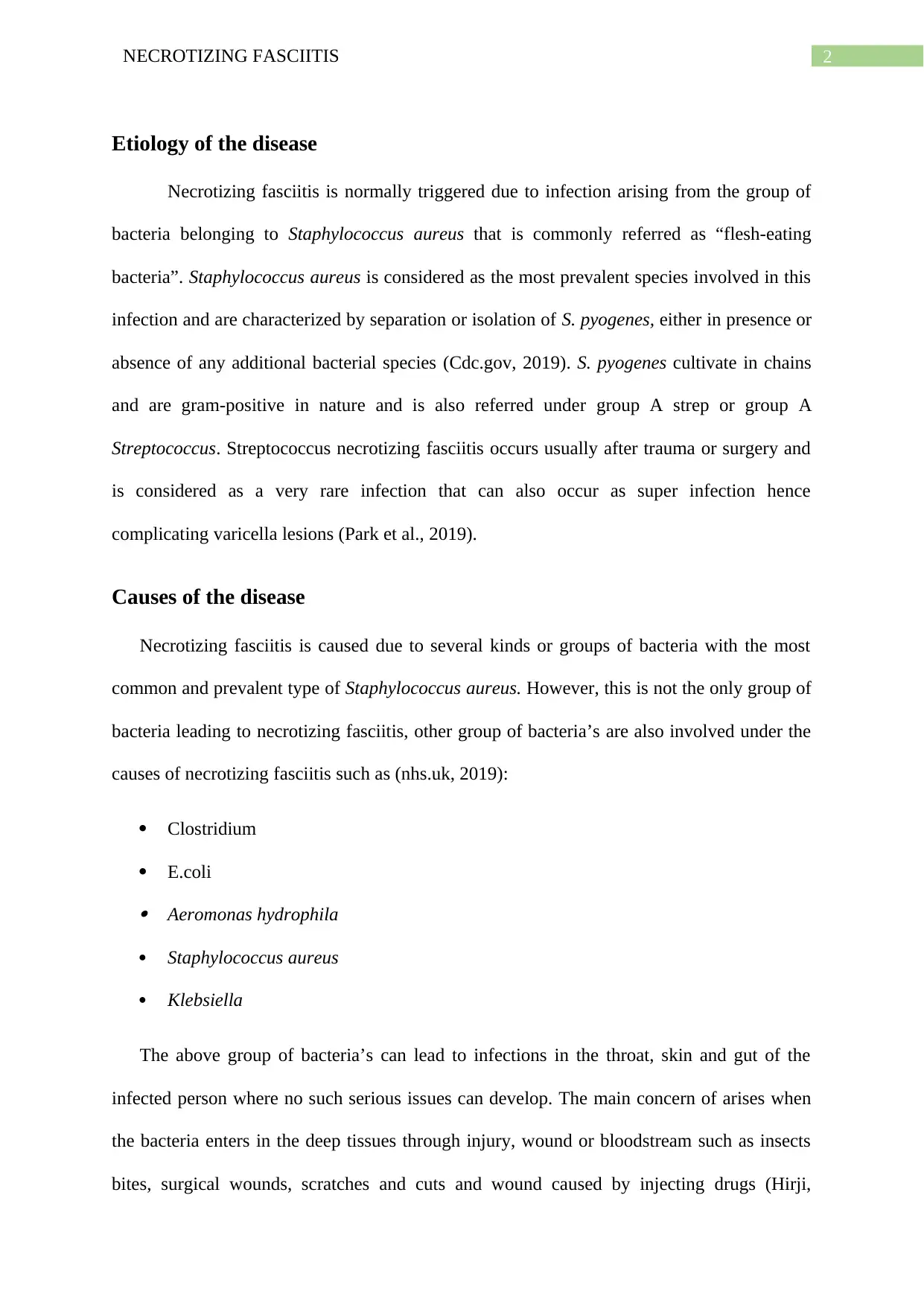
2NECROTIZING FASCIITIS
Etiology of the disease
Necrotizing fasciitis is normally triggered due to infection arising from the group of
bacteria belonging to Staphylococcus aureus that is commonly referred as “flesh-eating
bacteria”. Staphylococcus aureus is considered as the most prevalent species involved in this
infection and are characterized by separation or isolation of S. pyogenes, either in presence or
absence of any additional bacterial species (Cdc.gov, 2019). S. pyogenes cultivate in chains
and are gram-positive in nature and is also referred under group A strep or group A
Streptococcus. Streptococcus necrotizing fasciitis occurs usually after trauma or surgery and
is considered as a very rare infection that can also occur as super infection hence
complicating varicella lesions (Park et al., 2019).
Causes of the disease
Necrotizing fasciitis is caused due to several kinds or groups of bacteria with the most
common and prevalent type of Staphylococcus aureus. However, this is not the only group of
bacteria leading to necrotizing fasciitis, other group of bacteria’s are also involved under the
causes of necrotizing fasciitis such as (nhs.uk, 2019):
Clostridium
E.coli Aeromonas hydrophila
Staphylococcus aureus
Klebsiella
The above group of bacteria’s can lead to infections in the throat, skin and gut of the
infected person where no such serious issues can develop. The main concern of arises when
the bacteria enters in the deep tissues through injury, wound or bloodstream such as insects
bites, surgical wounds, scratches and cuts and wound caused by injecting drugs (Hirji,
Etiology of the disease
Necrotizing fasciitis is normally triggered due to infection arising from the group of
bacteria belonging to Staphylococcus aureus that is commonly referred as “flesh-eating
bacteria”. Staphylococcus aureus is considered as the most prevalent species involved in this
infection and are characterized by separation or isolation of S. pyogenes, either in presence or
absence of any additional bacterial species (Cdc.gov, 2019). S. pyogenes cultivate in chains
and are gram-positive in nature and is also referred under group A strep or group A
Streptococcus. Streptococcus necrotizing fasciitis occurs usually after trauma or surgery and
is considered as a very rare infection that can also occur as super infection hence
complicating varicella lesions (Park et al., 2019).
Causes of the disease
Necrotizing fasciitis is caused due to several kinds or groups of bacteria with the most
common and prevalent type of Staphylococcus aureus. However, this is not the only group of
bacteria leading to necrotizing fasciitis, other group of bacteria’s are also involved under the
causes of necrotizing fasciitis such as (nhs.uk, 2019):
Clostridium
E.coli Aeromonas hydrophila
Staphylococcus aureus
Klebsiella
The above group of bacteria’s can lead to infections in the throat, skin and gut of the
infected person where no such serious issues can develop. The main concern of arises when
the bacteria enters in the deep tissues through injury, wound or bloodstream such as insects
bites, surgical wounds, scratches and cuts and wound caused by injecting drugs (Hirji,
⊘ This is a preview!⊘
Do you want full access?
Subscribe today to unlock all pages.

Trusted by 1+ million students worldwide
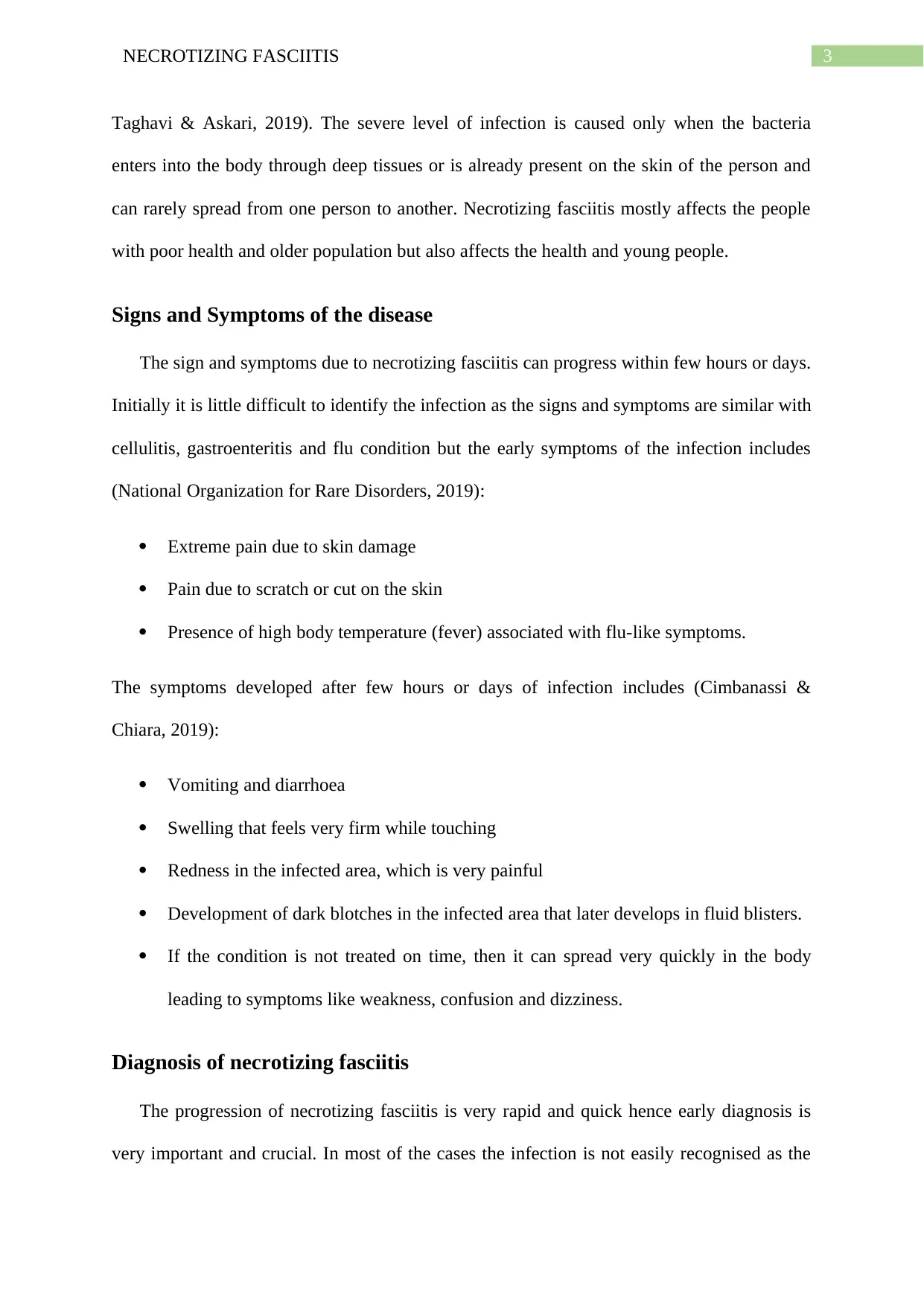
3NECROTIZING FASCIITIS
Taghavi & Askari, 2019). The severe level of infection is caused only when the bacteria
enters into the body through deep tissues or is already present on the skin of the person and
can rarely spread from one person to another. Necrotizing fasciitis mostly affects the people
with poor health and older population but also affects the health and young people.
Signs and Symptoms of the disease
The sign and symptoms due to necrotizing fasciitis can progress within few hours or days.
Initially it is little difficult to identify the infection as the signs and symptoms are similar with
cellulitis, gastroenteritis and flu condition but the early symptoms of the infection includes
(National Organization for Rare Disorders, 2019):
Extreme pain due to skin damage
Pain due to scratch or cut on the skin
Presence of high body temperature (fever) associated with flu-like symptoms.
The symptoms developed after few hours or days of infection includes (Cimbanassi &
Chiara, 2019):
Vomiting and diarrhoea
Swelling that feels very firm while touching
Redness in the infected area, which is very painful
Development of dark blotches in the infected area that later develops in fluid blisters.
If the condition is not treated on time, then it can spread very quickly in the body
leading to symptoms like weakness, confusion and dizziness.
Diagnosis of necrotizing fasciitis
The progression of necrotizing fasciitis is very rapid and quick hence early diagnosis is
very important and crucial. In most of the cases the infection is not easily recognised as the
Taghavi & Askari, 2019). The severe level of infection is caused only when the bacteria
enters into the body through deep tissues or is already present on the skin of the person and
can rarely spread from one person to another. Necrotizing fasciitis mostly affects the people
with poor health and older population but also affects the health and young people.
Signs and Symptoms of the disease
The sign and symptoms due to necrotizing fasciitis can progress within few hours or days.
Initially it is little difficult to identify the infection as the signs and symptoms are similar with
cellulitis, gastroenteritis and flu condition but the early symptoms of the infection includes
(National Organization for Rare Disorders, 2019):
Extreme pain due to skin damage
Pain due to scratch or cut on the skin
Presence of high body temperature (fever) associated with flu-like symptoms.
The symptoms developed after few hours or days of infection includes (Cimbanassi &
Chiara, 2019):
Vomiting and diarrhoea
Swelling that feels very firm while touching
Redness in the infected area, which is very painful
Development of dark blotches in the infected area that later develops in fluid blisters.
If the condition is not treated on time, then it can spread very quickly in the body
leading to symptoms like weakness, confusion and dizziness.
Diagnosis of necrotizing fasciitis
The progression of necrotizing fasciitis is very rapid and quick hence early diagnosis is
very important and crucial. In most of the cases the infection is not easily recognised as the
Paraphrase This Document
Need a fresh take? Get an instant paraphrase of this document with our AI Paraphraser
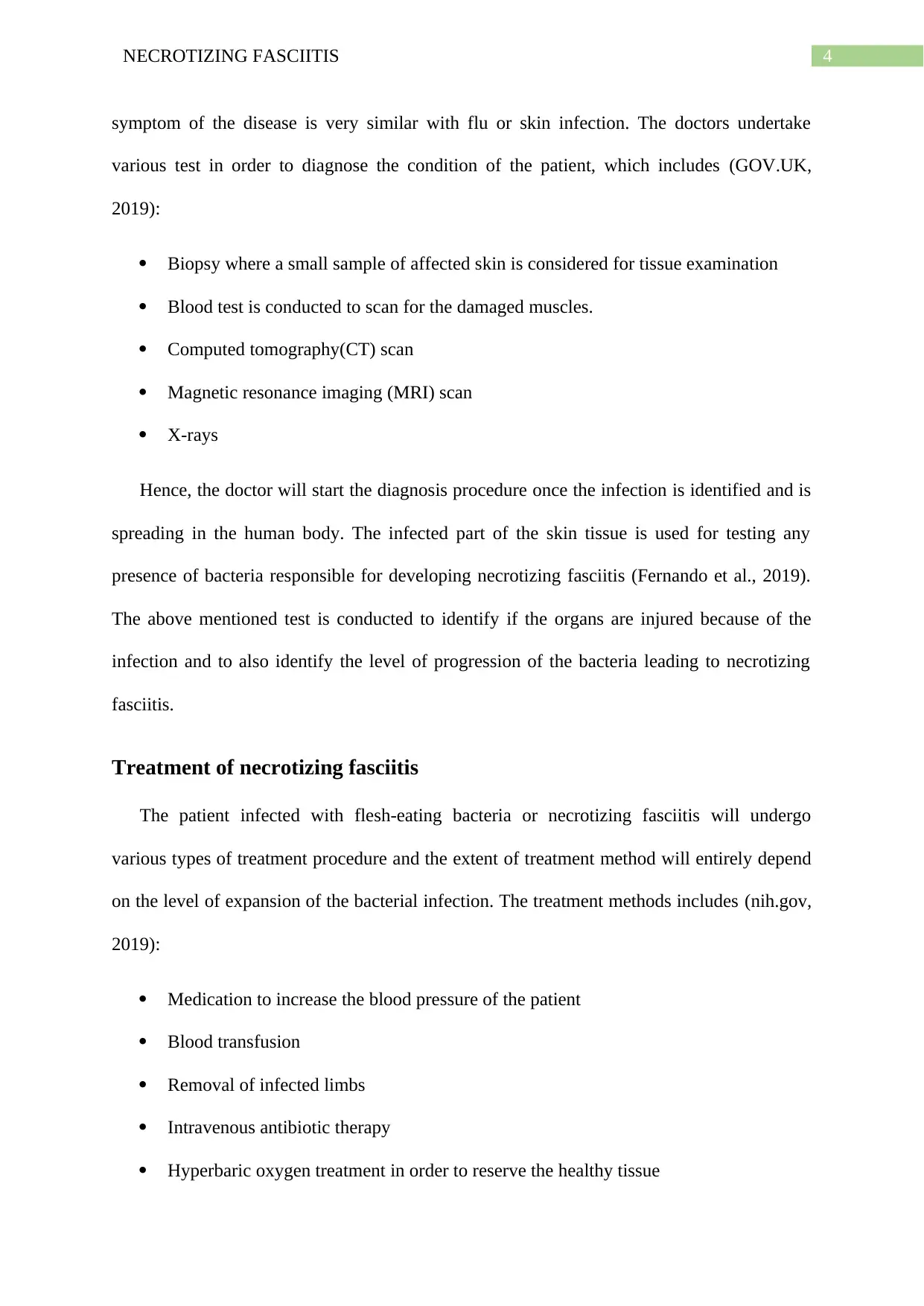
4NECROTIZING FASCIITIS
symptom of the disease is very similar with flu or skin infection. The doctors undertake
various test in order to diagnose the condition of the patient, which includes (GOV.UK,
2019):
Biopsy where a small sample of affected skin is considered for tissue examination
Blood test is conducted to scan for the damaged muscles.
Computed tomography(CT) scan
Magnetic resonance imaging (MRI) scan
X-rays
Hence, the doctor will start the diagnosis procedure once the infection is identified and is
spreading in the human body. The infected part of the skin tissue is used for testing any
presence of bacteria responsible for developing necrotizing fasciitis (Fernando et al., 2019).
The above mentioned test is conducted to identify if the organs are injured because of the
infection and to also identify the level of progression of the bacteria leading to necrotizing
fasciitis.
Treatment of necrotizing fasciitis
The patient infected with flesh-eating bacteria or necrotizing fasciitis will undergo
various types of treatment procedure and the extent of treatment method will entirely depend
on the level of expansion of the bacterial infection. The treatment methods includes (nih.gov,
2019):
Medication to increase the blood pressure of the patient
Blood transfusion
Removal of infected limbs
Intravenous antibiotic therapy
Hyperbaric oxygen treatment in order to reserve the healthy tissue
symptom of the disease is very similar with flu or skin infection. The doctors undertake
various test in order to diagnose the condition of the patient, which includes (GOV.UK,
2019):
Biopsy where a small sample of affected skin is considered for tissue examination
Blood test is conducted to scan for the damaged muscles.
Computed tomography(CT) scan
Magnetic resonance imaging (MRI) scan
X-rays
Hence, the doctor will start the diagnosis procedure once the infection is identified and is
spreading in the human body. The infected part of the skin tissue is used for testing any
presence of bacteria responsible for developing necrotizing fasciitis (Fernando et al., 2019).
The above mentioned test is conducted to identify if the organs are injured because of the
infection and to also identify the level of progression of the bacteria leading to necrotizing
fasciitis.
Treatment of necrotizing fasciitis
The patient infected with flesh-eating bacteria or necrotizing fasciitis will undergo
various types of treatment procedure and the extent of treatment method will entirely depend
on the level of expansion of the bacterial infection. The treatment methods includes (nih.gov,
2019):
Medication to increase the blood pressure of the patient
Blood transfusion
Removal of infected limbs
Intravenous antibiotic therapy
Hyperbaric oxygen treatment in order to reserve the healthy tissue
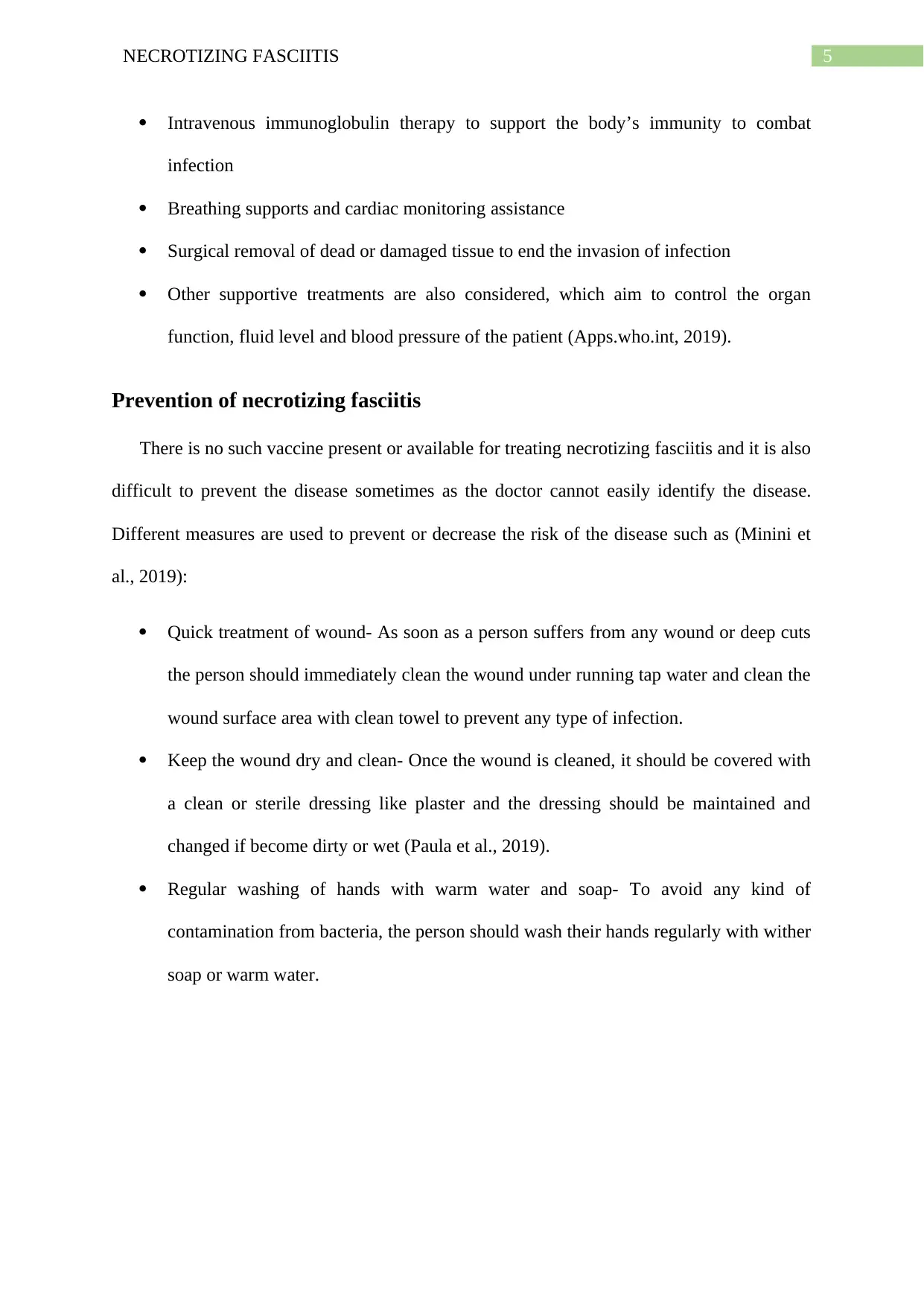
5NECROTIZING FASCIITIS
Intravenous immunoglobulin therapy to support the body’s immunity to combat
infection
Breathing supports and cardiac monitoring assistance
Surgical removal of dead or damaged tissue to end the invasion of infection
Other supportive treatments are also considered, which aim to control the organ
function, fluid level and blood pressure of the patient (Apps.who.int, 2019).
Prevention of necrotizing fasciitis
There is no such vaccine present or available for treating necrotizing fasciitis and it is also
difficult to prevent the disease sometimes as the doctor cannot easily identify the disease.
Different measures are used to prevent or decrease the risk of the disease such as (Minini et
al., 2019):
Quick treatment of wound- As soon as a person suffers from any wound or deep cuts
the person should immediately clean the wound under running tap water and clean the
wound surface area with clean towel to prevent any type of infection.
Keep the wound dry and clean- Once the wound is cleaned, it should be covered with
a clean or sterile dressing like plaster and the dressing should be maintained and
changed if become dirty or wet (Paula et al., 2019).
Regular washing of hands with warm water and soap- To avoid any kind of
contamination from bacteria, the person should wash their hands regularly with wither
soap or warm water.
Intravenous immunoglobulin therapy to support the body’s immunity to combat
infection
Breathing supports and cardiac monitoring assistance
Surgical removal of dead or damaged tissue to end the invasion of infection
Other supportive treatments are also considered, which aim to control the organ
function, fluid level and blood pressure of the patient (Apps.who.int, 2019).
Prevention of necrotizing fasciitis
There is no such vaccine present or available for treating necrotizing fasciitis and it is also
difficult to prevent the disease sometimes as the doctor cannot easily identify the disease.
Different measures are used to prevent or decrease the risk of the disease such as (Minini et
al., 2019):
Quick treatment of wound- As soon as a person suffers from any wound or deep cuts
the person should immediately clean the wound under running tap water and clean the
wound surface area with clean towel to prevent any type of infection.
Keep the wound dry and clean- Once the wound is cleaned, it should be covered with
a clean or sterile dressing like plaster and the dressing should be maintained and
changed if become dirty or wet (Paula et al., 2019).
Regular washing of hands with warm water and soap- To avoid any kind of
contamination from bacteria, the person should wash their hands regularly with wither
soap or warm water.
⊘ This is a preview!⊘
Do you want full access?
Subscribe today to unlock all pages.

Trusted by 1+ million students worldwide
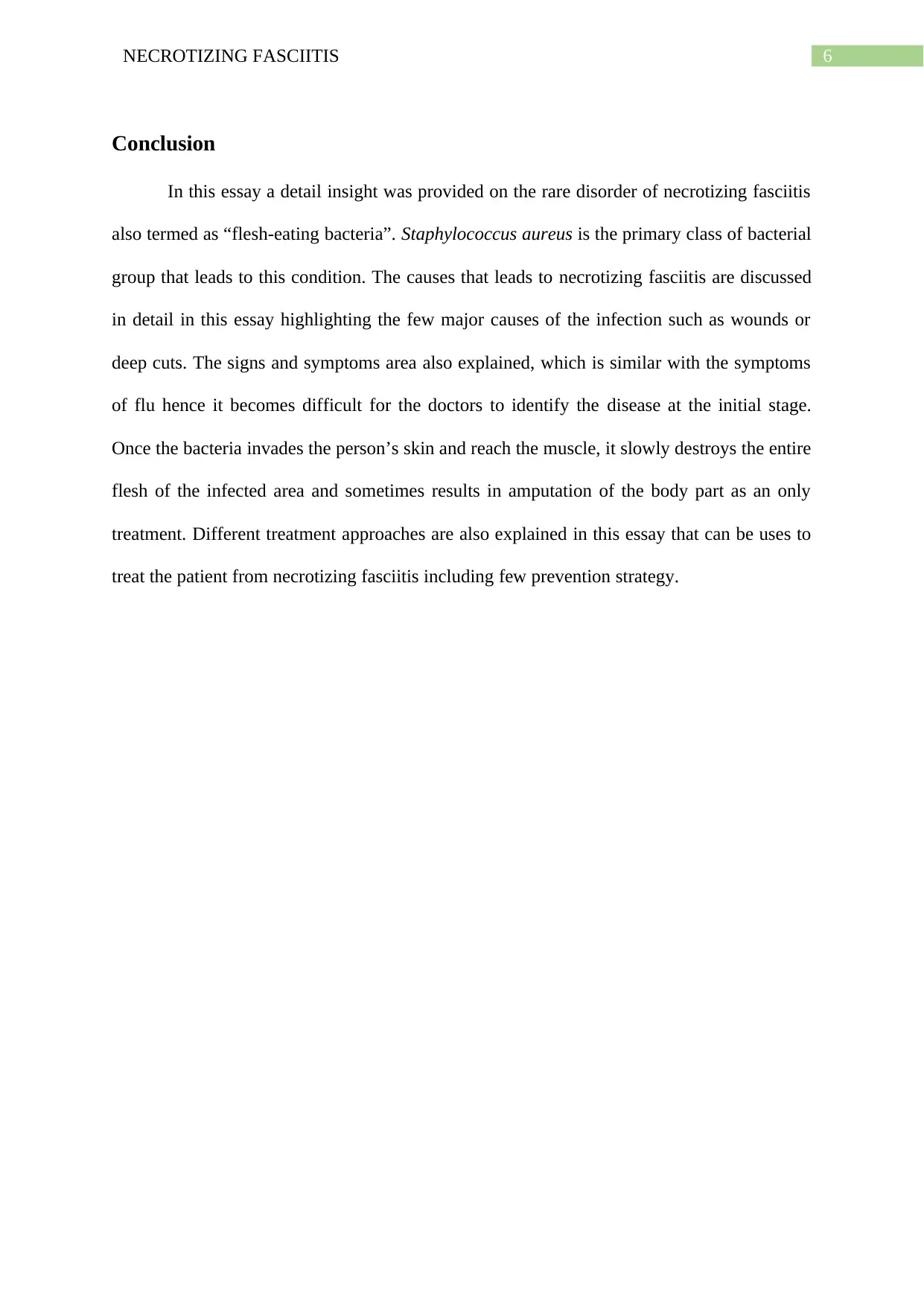
6NECROTIZING FASCIITIS
Conclusion
In this essay a detail insight was provided on the rare disorder of necrotizing fasciitis
also termed as “flesh-eating bacteria”. Staphylococcus aureus is the primary class of bacterial
group that leads to this condition. The causes that leads to necrotizing fasciitis are discussed
in detail in this essay highlighting the few major causes of the infection such as wounds or
deep cuts. The signs and symptoms area also explained, which is similar with the symptoms
of flu hence it becomes difficult for the doctors to identify the disease at the initial stage.
Once the bacteria invades the person’s skin and reach the muscle, it slowly destroys the entire
flesh of the infected area and sometimes results in amputation of the body part as an only
treatment. Different treatment approaches are also explained in this essay that can be uses to
treat the patient from necrotizing fasciitis including few prevention strategy.
Conclusion
In this essay a detail insight was provided on the rare disorder of necrotizing fasciitis
also termed as “flesh-eating bacteria”. Staphylococcus aureus is the primary class of bacterial
group that leads to this condition. The causes that leads to necrotizing fasciitis are discussed
in detail in this essay highlighting the few major causes of the infection such as wounds or
deep cuts. The signs and symptoms area also explained, which is similar with the symptoms
of flu hence it becomes difficult for the doctors to identify the disease at the initial stage.
Once the bacteria invades the person’s skin and reach the muscle, it slowly destroys the entire
flesh of the infected area and sometimes results in amputation of the body part as an only
treatment. Different treatment approaches are also explained in this essay that can be uses to
treat the patient from necrotizing fasciitis including few prevention strategy.
Paraphrase This Document
Need a fresh take? Get an instant paraphrase of this document with our AI Paraphraser
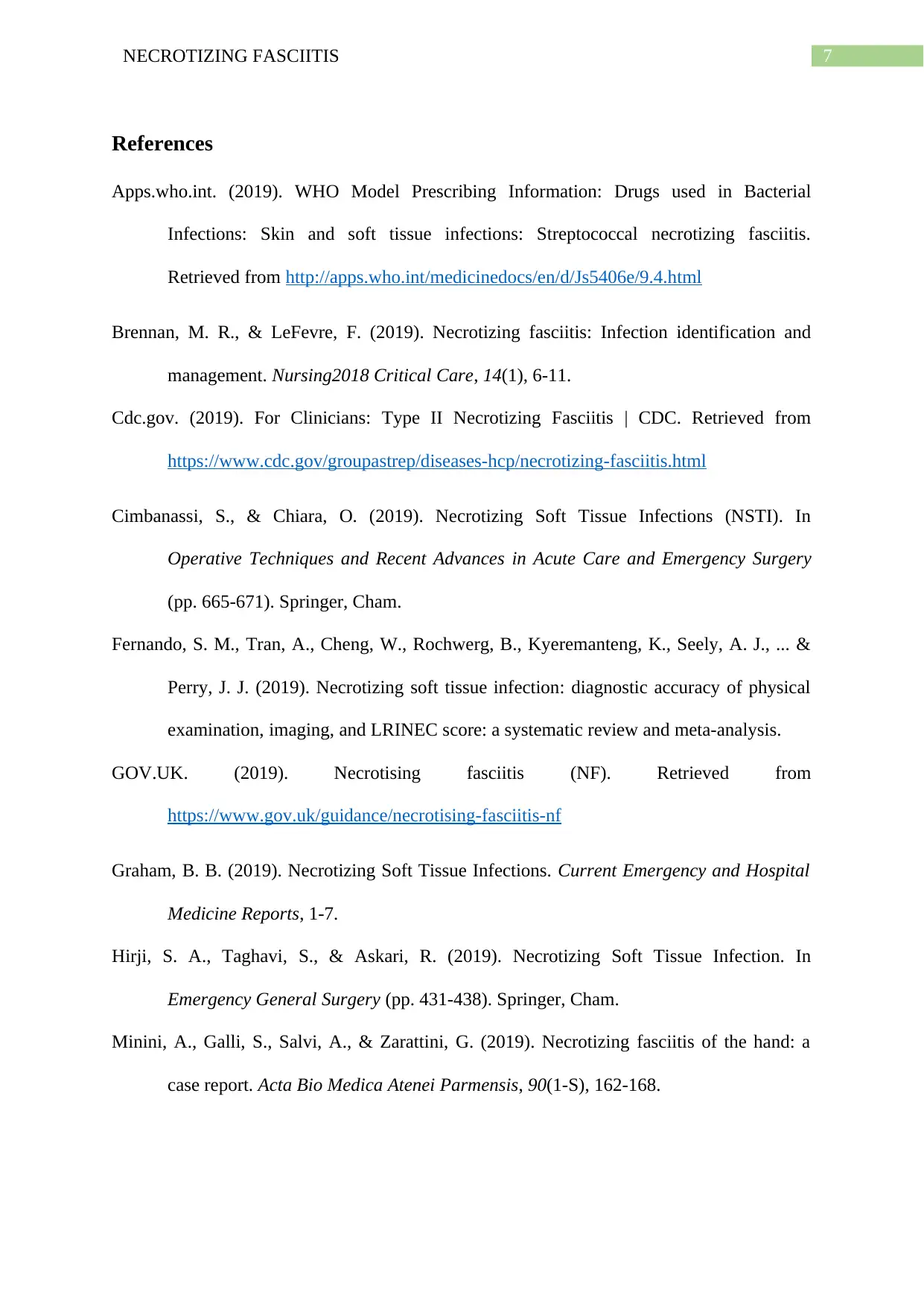
7NECROTIZING FASCIITIS
References
Apps.who.int. (2019). WHO Model Prescribing Information: Drugs used in Bacterial
Infections: Skin and soft tissue infections: Streptococcal necrotizing fasciitis.
Retrieved from http://apps.who.int/medicinedocs/en/d/Js5406e/9.4.html
Brennan, M. R., & LeFevre, F. (2019). Necrotizing fasciitis: Infection identification and
management. Nursing2018 Critical Care, 14(1), 6-11.
Cdc.gov. (2019). For Clinicians: Type II Necrotizing Fasciitis | CDC. Retrieved from
https://www.cdc.gov/groupastrep/diseases-hcp/necrotizing-fasciitis.html
Cimbanassi, S., & Chiara, O. (2019). Necrotizing Soft Tissue Infections (NSTI). In
Operative Techniques and Recent Advances in Acute Care and Emergency Surgery
(pp. 665-671). Springer, Cham.
Fernando, S. M., Tran, A., Cheng, W., Rochwerg, B., Kyeremanteng, K., Seely, A. J., ... &
Perry, J. J. (2019). Necrotizing soft tissue infection: diagnostic accuracy of physical
examination, imaging, and LRINEC score: a systematic review and meta-analysis.
GOV.UK. (2019). Necrotising fasciitis (NF). Retrieved from
https://www.gov.uk/guidance/necrotising-fasciitis-nf
Graham, B. B. (2019). Necrotizing Soft Tissue Infections. Current Emergency and Hospital
Medicine Reports, 1-7.
Hirji, S. A., Taghavi, S., & Askari, R. (2019). Necrotizing Soft Tissue Infection. In
Emergency General Surgery (pp. 431-438). Springer, Cham.
Minini, A., Galli, S., Salvi, A., & Zarattini, G. (2019). Necrotizing fasciitis of the hand: a
case report. Acta Bio Medica Atenei Parmensis, 90(1-S), 162-168.
References
Apps.who.int. (2019). WHO Model Prescribing Information: Drugs used in Bacterial
Infections: Skin and soft tissue infections: Streptococcal necrotizing fasciitis.
Retrieved from http://apps.who.int/medicinedocs/en/d/Js5406e/9.4.html
Brennan, M. R., & LeFevre, F. (2019). Necrotizing fasciitis: Infection identification and
management. Nursing2018 Critical Care, 14(1), 6-11.
Cdc.gov. (2019). For Clinicians: Type II Necrotizing Fasciitis | CDC. Retrieved from
https://www.cdc.gov/groupastrep/diseases-hcp/necrotizing-fasciitis.html
Cimbanassi, S., & Chiara, O. (2019). Necrotizing Soft Tissue Infections (NSTI). In
Operative Techniques and Recent Advances in Acute Care and Emergency Surgery
(pp. 665-671). Springer, Cham.
Fernando, S. M., Tran, A., Cheng, W., Rochwerg, B., Kyeremanteng, K., Seely, A. J., ... &
Perry, J. J. (2019). Necrotizing soft tissue infection: diagnostic accuracy of physical
examination, imaging, and LRINEC score: a systematic review and meta-analysis.
GOV.UK. (2019). Necrotising fasciitis (NF). Retrieved from
https://www.gov.uk/guidance/necrotising-fasciitis-nf
Graham, B. B. (2019). Necrotizing Soft Tissue Infections. Current Emergency and Hospital
Medicine Reports, 1-7.
Hirji, S. A., Taghavi, S., & Askari, R. (2019). Necrotizing Soft Tissue Infection. In
Emergency General Surgery (pp. 431-438). Springer, Cham.
Minini, A., Galli, S., Salvi, A., & Zarattini, G. (2019). Necrotizing fasciitis of the hand: a
case report. Acta Bio Medica Atenei Parmensis, 90(1-S), 162-168.
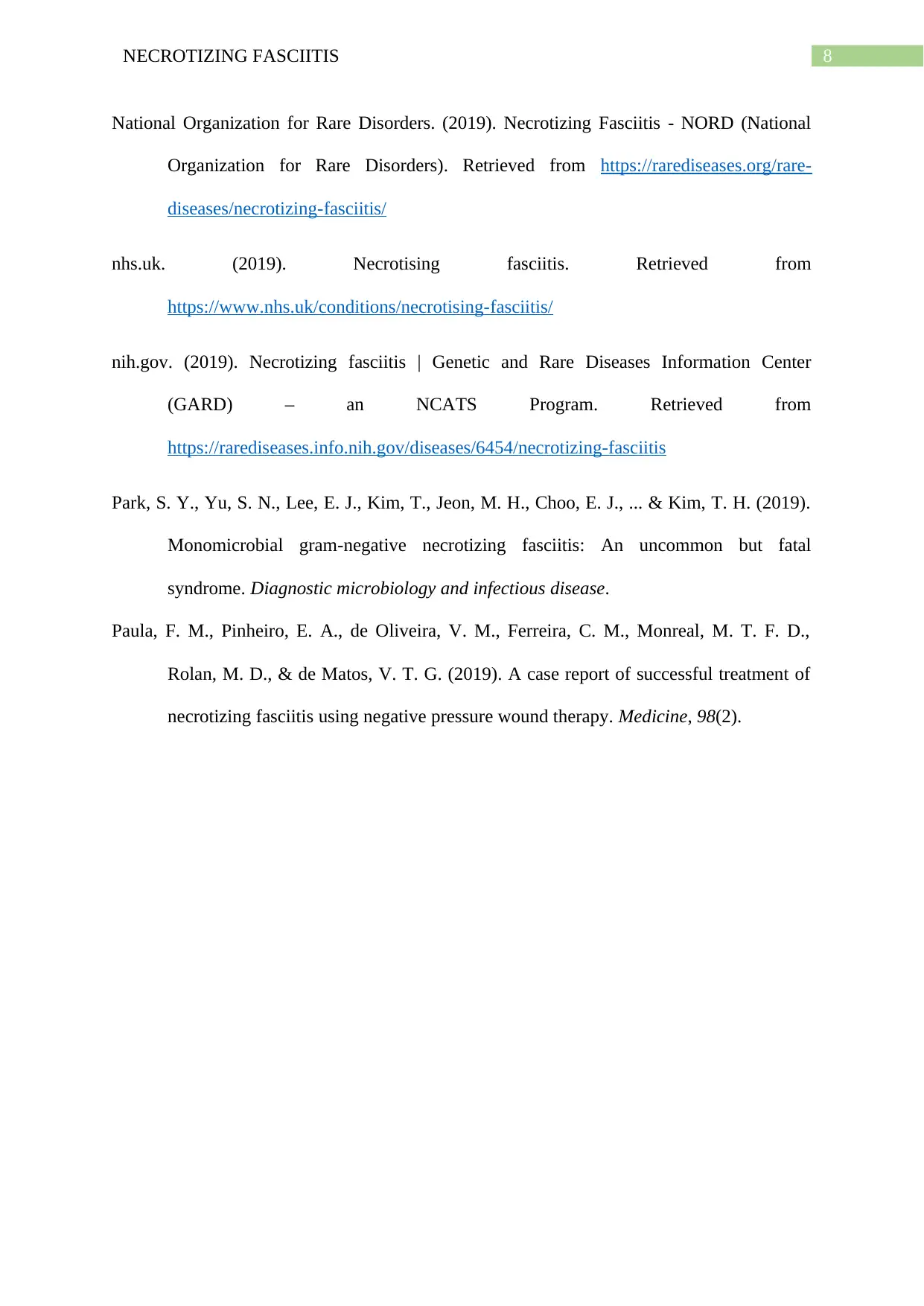
8NECROTIZING FASCIITIS
National Organization for Rare Disorders. (2019). Necrotizing Fasciitis - NORD (National
Organization for Rare Disorders). Retrieved from https://rarediseases.org/rare-
diseases/necrotizing-fasciitis/
nhs.uk. (2019). Necrotising fasciitis. Retrieved from
https://www.nhs.uk/conditions/necrotising-fasciitis/
nih.gov. (2019). Necrotizing fasciitis | Genetic and Rare Diseases Information Center
(GARD) – an NCATS Program. Retrieved from
https://rarediseases.info.nih.gov/diseases/6454/necrotizing-fasciitis
Park, S. Y., Yu, S. N., Lee, E. J., Kim, T., Jeon, M. H., Choo, E. J., ... & Kim, T. H. (2019).
Monomicrobial gram-negative necrotizing fasciitis: An uncommon but fatal
syndrome. Diagnostic microbiology and infectious disease.
Paula, F. M., Pinheiro, E. A., de Oliveira, V. M., Ferreira, C. M., Monreal, M. T. F. D.,
Rolan, M. D., & de Matos, V. T. G. (2019). A case report of successful treatment of
necrotizing fasciitis using negative pressure wound therapy. Medicine, 98(2).
National Organization for Rare Disorders. (2019). Necrotizing Fasciitis - NORD (National
Organization for Rare Disorders). Retrieved from https://rarediseases.org/rare-
diseases/necrotizing-fasciitis/
nhs.uk. (2019). Necrotising fasciitis. Retrieved from
https://www.nhs.uk/conditions/necrotising-fasciitis/
nih.gov. (2019). Necrotizing fasciitis | Genetic and Rare Diseases Information Center
(GARD) – an NCATS Program. Retrieved from
https://rarediseases.info.nih.gov/diseases/6454/necrotizing-fasciitis
Park, S. Y., Yu, S. N., Lee, E. J., Kim, T., Jeon, M. H., Choo, E. J., ... & Kim, T. H. (2019).
Monomicrobial gram-negative necrotizing fasciitis: An uncommon but fatal
syndrome. Diagnostic microbiology and infectious disease.
Paula, F. M., Pinheiro, E. A., de Oliveira, V. M., Ferreira, C. M., Monreal, M. T. F. D.,
Rolan, M. D., & de Matos, V. T. G. (2019). A case report of successful treatment of
necrotizing fasciitis using negative pressure wound therapy. Medicine, 98(2).
⊘ This is a preview!⊘
Do you want full access?
Subscribe today to unlock all pages.

Trusted by 1+ million students worldwide
1 out of 9
Related Documents
Your All-in-One AI-Powered Toolkit for Academic Success.
+13062052269
info@desklib.com
Available 24*7 on WhatsApp / Email
![[object Object]](/_next/static/media/star-bottom.7253800d.svg)
Unlock your academic potential
Copyright © 2020–2025 A2Z Services. All Rights Reserved. Developed and managed by ZUCOL.





